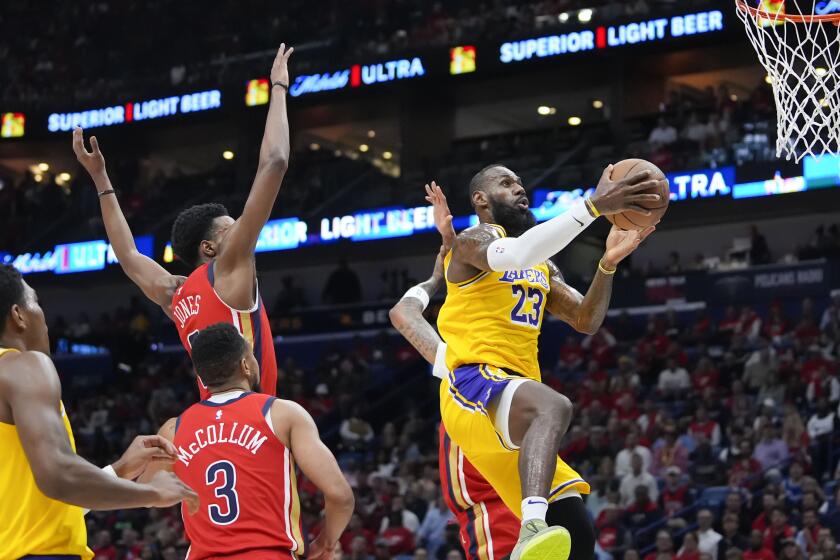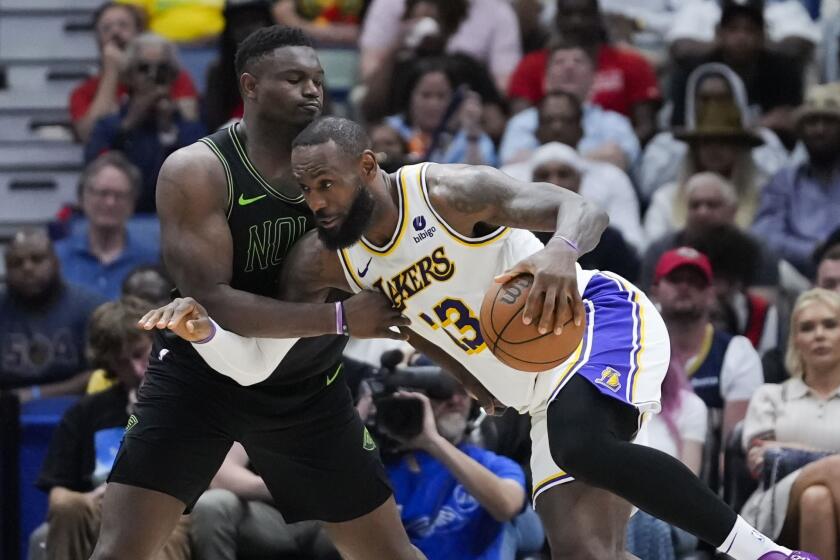Taking time to case the joint
There it is: the knee.
Of course, this is not just any everyday, humdrum knee. This is Andrew Bynum’s left knee, at the moment injured and incapable.
“It’s going to be fine,” Bynum assures, looking down at it. “Everything is going to be fine and I’m going to be back soon. I just have to be patient.”
You hear him say this and pray he’s right.
For how his knee heals, how it responds to time, therapy and determination, will make all the difference for the Lakers this season. If it’s healthy in about a month, as the team claims it should be, Bynum returns and the Lakers become a juggernaut.
If it doesn’t heal, getting past the second round of the playoffs will be a toss-up. Another quick postseason exit would slam Los Angeles’ proudest franchise like a vicious tornado. Nobody knows what would remain.
It is Friday. Bynum -- 20 years old, 7 feet tall, an innocence about him -- sits with me on a set of bleachers at the Lakers’ practice gym.
Much has changed since that mid-January game at Staples Center when he jumped, landed and ended up in a heap of agony. He suffered a deep bone bruise and his kneecap had popped off its moorings. Nothing good.
In the last two weeks, of course, the Lakers sought relief by adding an All-Star force: Pau Gasol. But the NBA’s Western Conference is as stacked as ever. Even Shaquille O’Neal is among us again. For the Lakers to become the best of the bunch, they’ll need to peak in the playoffs. And for that to happen, Bynum and his knee must be back.
Yes, there it is: the knee. Bynum touches it. It is strafed with small bandages meant to keep every last muscle fiber in check. More telling, it is still swollen.
My eyebrows rise. Maybe the injury is worse than we’ve been told.
“It’s just . . . well, it’s just puffy,” Bynum says, mumbling the way kids do. “I’m able to walk normally, but I can’t run because the muscles are not firing right. That’s because of the swelling. It will be fine, though. . . . I can’t wait to get back because life is just boring right now.”
Life has become a daily dose of rehab: massages, ice and heat, balancing, hopping, and lifting light weights. When he’s not working on his knee at a Westside clinic he spends hours at the Westchester home he shares with his mother, playing video games. About the only excitement he has had of late is getting the chance to visit Hollywood restaurants he’d never been to before.
Everywhere he goes, people wish him well. “It’s really, you know, it’s really cool,” he said. “I walk around and notice that people are treating me differently now. They see that I was doing well and becoming good at my profession and people, they like to see other people who are doing well and winning.”
With that thought -- the thought of how he’d been playing before the injury -- the conversation turns serious.
“Psychologically,” he says, “the injury was terrible. I felt I was just getting started.”
He notes that the way the season was unfolding -- he averages about 13 points and 10 rebounds a game, not quite doubling last year’s numbers -- has given him pride and confidence.
He says he is no longer the teenage prodigy burdened by potential. No longer the kid who didn’t have a clue about what it takes to be great, the kid who ate Snickers bars before games, the kid who felt like he’d become a team scapegoat when critics said that he should be traded for an All-Star.
He laughs, thinking of how, before the injury, he’d begun silencing the skeptics.
In the off-season, none other than Kobe Bryant said Bynum should go. You’ve got to be feeling pretty good, I say, since this season you were showing Kobe what’s what.
The kid is sharp. Politician sharp. All he cops to is that Kobe’s rant and the talk of trades put a chip on his shoulder and fueled his motivation. He says he understands why Kobe said what he did. He says his relationship with Kobe is solid, as good as ever.
Bynum would really rather think about the future than dwell on the past. He can’t stop imagining what it will be like to play alongside Gasol.
“People might wonder how we’re going to do with so many options,” he says, looking out at the court in front of him. “Are we going to be sharing the ball? Yes we are. Believe me, offense will not be our problem.”
The key will be defense.
With the steady precision of a computer programmer dissecting code, he begins breaking down the Lakers’ defense. His eyes light as he talks about “expansion and contraction” on the pick-and-roll, about the importance of reacting quickly to “threatening action that happens on the wing.” He goes on, speaking of the “pinch-post” and defensive shifts, of flow and communication, of weak-side help and the importance of defending the pass before the pass that leads to a score.
“It’s like hockey,” he says.
Hockey?
“Well, if we can get better at all of that, look out.”
Impressive.
He brushes a hand on his left leg.
“We can take the championship,” he says. “I really feel that. You can’t make guarantees, but right now we have a really good chance.”
Everything rides on that swollen knee.
Kurt Streeter can be reached at kurt.streeter@latimes.com. To read previous columns by Streeter, go to latimes.com/streeter
More to Read
All things Lakers, all the time.
Get all the Lakers news you need in Dan Woike's weekly newsletter.
You may occasionally receive promotional content from the Los Angeles Times.







